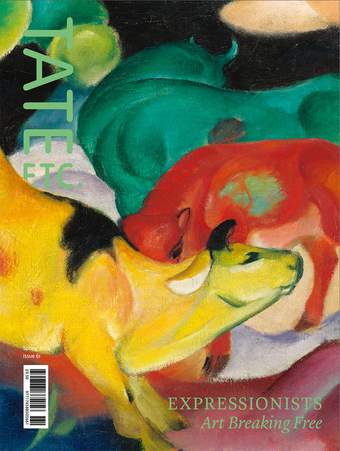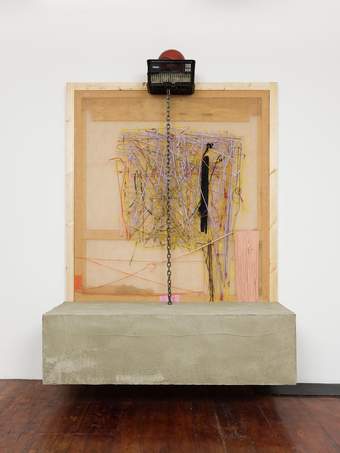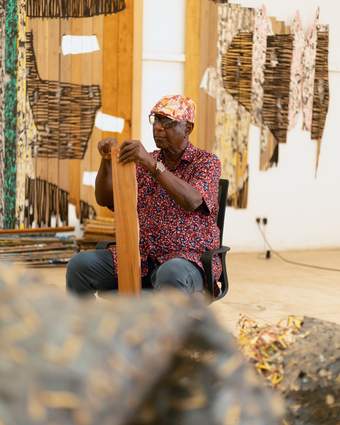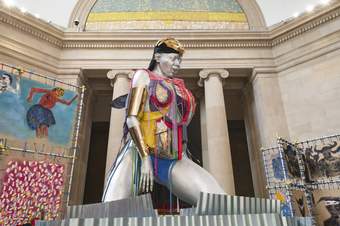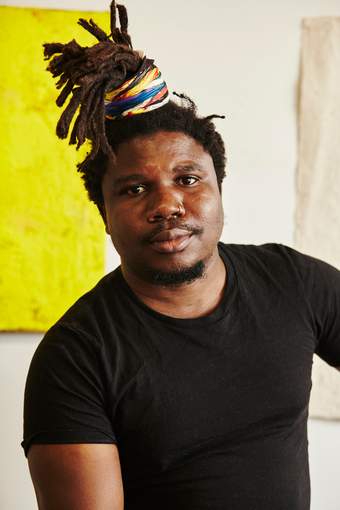
Alvaro Barrington in his Whitechapel studio
Photo: Jeremiah Cumberbatch
HANNAH MARSH You’ve lived in many different places, and this is referenced in your work. How has where you’ve lived shaped who you’ve become?
ALVARO BARRINGTON I grew up in Flatbush, Brooklyn, and my family is from Grenada. But I was born in Venezuela. I took art classes in school, but it was only in Venezuela that I decided to become an artist. I went back there for the first time when I was 27.
HM What was that like?
AB I couldn’t say that I chose to become a painter. It was always something that was encouraged. But in Venezuela, I found I was choosing art myself. I didn’t know anybody there, and for some reason I started hanging out with artists. I was removed from the arbitrary structural reasons as to why you become friends with people, and the community I gravitated towards was creative. I went on the Orinoco River for some time. It was a moment of quiet. And something kind of dawned on me. It was like a second birth.
HM Carnival is integral to your work, and so beautifully woven into your practice. Why is that?
AB I grew up going to carnival in New York and went to Notting Hill Carnival my first year in London. It was so much fun – it had so much life, and a history that I understood. So when I started painting, it felt like the painting itself was immediately steeped in that history. There were ideas or motifs I borrowed, like the ‘wet fete’ figure. At carnival in the Caribbean, during a wet fete where partygoers are sometimes sprayed with firehoses, you’d see a girl dancing in her underwear, and you’d know that this space was for her, not for you. And I thought, as an art historical nerd, that I’ve been conditioned in that way – to know that this space was for her – and that it was interesting to see the difference between a Gauguin bather, or a Lisa Brice bather, in terms of how the artists look at women. I wondered if I, as a Caribbean American man, could paint women in a way that made the viewer realise that it’s her space.
HM I think there’s something else in your work – bringing the carnival to people, wherever they are, especially if they are unable to go. Which is so lovely, and so powerful. I’ve enjoyed showing my elderly Saint Lucian gran your carnival paintings, for example. And I guess that’s why you make art – because you want people to have that experience.
AB Yeah, exactly. My stepdad was a very stern guy. I once painted him a hibiscus flower, and he started getting into all these stories about his time in St Kitts, stories he’d never really shared with the family. It was interesting to think about that – what this random painting of a flower meant to him.
HM Let’s talk about your forthcoming commission. You’ve spoken about Tate Britain’s proximity to the river, and wanting to transform the gallery into something that is welcoming, and safe.
AB I was interested in the idea of a commission that would open up and connect different parts of the building. There are all these histories to see in different parts of Tate Britain, and the work is a way to bring them together.
HM Your family’s home in Grenada is also a key part of the commission. Could you talk about what Grenada means to you?
AB I went to a very middle-class school in New York, and there was this idea that the Caribbean, Grenada, was poor. The idea of a place where you take things slow – where you can hang out with your family or friends for hours – doesn’t make sense in the kind of working, bustling mentality of New York. But that perception of poverty didn’t connect to my experience. Grenada was the safest place I ever knew; it was the most fun place I ever knew.
I thought it would be an interesting point to start the exhibition from. It’s part of my material, and how I’ve worked in the past – going back to a memory I have of lying with my grandmother in her house, hearing the rain hitting the corrugated tin roof. Feeling safe, feeling happy.
HM What can people expect from your commission?
AB Home.
Tate Britain Commission: Alvaro Barrington, Duveen Galleries, Tate Britain, 29 May 2024 – 26 January 2025.
Alvaro Barrington is an artist who lives in London. He talked to Hannah Marsh, Assistant Curator, Contemporary British Art, Tate Britain.
Supported by Bottega Veneta. With additional support from The Alvaro Barrington Exhibition Supporters Circle and Tate Americas Foundation.

